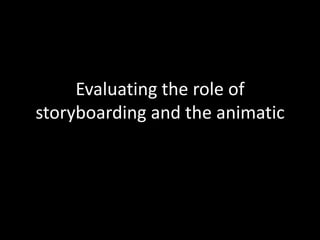
Evalutating role of storyboard and animatics
- 1. Evaluating the role of storyboarding and the animatic
- 2. What is a storyboard? • A storyboard is a graphical representation of the camera shots in a film sequence, in this case we drew the shots for our music video. We had to draw them in order to create a narrative. • Its visualized by a series of drawings which depict the fundamental elements of our music video: location, characters, props and the settings of each shot. • We also added at the side of each individual shot details about the timing, location, movement, lighting, camera direction and shot number. This helps us when shooting on the day, to know what we are doing and to make our video shoot more efficient.
- 3. What is a storyboard for? • It enables the people involved with the filming to visualize what is going to happen on the actual shoot day, making it more efficient. • By helping the creators visualize it, it enables them to see whether the idea will work or not and whether it is doable. • An important element of the storyboard is that is creates a flow of narrative even before the footage is actually shot.
- 4. When are storyboards used? • Storyboards are used in 3 main areas: 1. Pre-production (before shooting) 2. Production (during shooting) 3. Post-production (after shooting)
- 5. What does a storyboard look like?
- 6. What is an animatic? • An animatic is the filmed version of the storyboards drawings. The shots are timed to what the actual shots will supposedly look like. This helps highlight any problems. • An animatic is the best visual way to show the flow of the narrative. Unlike storyboards it is actual filmed footage, so is more visually accurate than the storyboard.
- 7. What is an animatic used for? • The animatic is the next stage from the storyboard. It gives a better idea of how the scene will look and feel with motion and timing. It gives a better indication of the narrative than the story board because its film footage. • It highlights the issues with editing, camera angles and timing problems that might have not been obvious with the storyboard.
- 8. When is an animatic used? • Like storyboards, an animatic is used in 3 main areas: 1. Pre-production (before shooting) 2. Production (during shooting) 3. Post-production (after shooting)